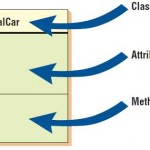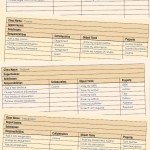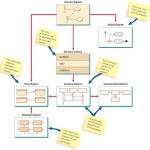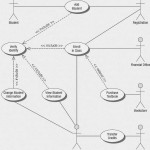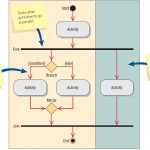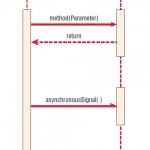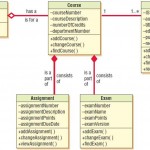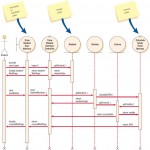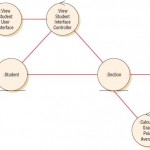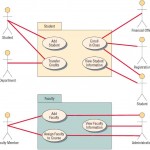Object-oriented analysis and design can offer an approach that facilitates logical, rapid, and thorough methods for creating new systems responsive to a changing business landscape. Object-oriented techniques work well in situations in which … [Read more...] about Object-Oriented Systems Analysis and Design Using UML
Object-Oriented Systems Analysis and Design Using UML
Object-Oriented Concepts – Objects/Classes/Inheritance
Object-oriented programming differs from traditional procedural programming by examining the objects that are part of a system. Each object is a computer representation of some actual thing or event. General descriptions of the key object-oriented … [Read more...] about Object-Oriented Concepts – Objects/Classes/Inheritance
CRC Cards and Object Think
Now that we have covered the fundamental concepts of object-oriented systems analysis and design, we need to examine ways to create classes and objects from the business problems and systems we are facing. One way to begin enacting the … [Read more...] about CRC Cards and Object Think
The Unified Modeling Language (UML) Concepts and Diagrams
The UML approach is well worth investigating and understanding, due to its wide acceptance and usage. UML provides a standardized set of tools to document the analysis and design of a software system. The UML toolset includes diagrams that allow … [Read more...] about The Unified Modeling Language (UML) Concepts and Diagrams
Use Case Modeling
UML is fundamentally based on an object-oriented analysis technique known as use case modeling, which was introduced in Chapter "Understanding and Modeling Organizational Systems". A use case model shows a view of the system from the user … [Read more...] about Use Case Modeling
Activity Diagrams – Introduction
Activity diagrams show the sequence of activities in a process, including sequential and parallel activities, and decisions that are made. An activity diagram is usually created for one use case and may show the different possible scenarios.The … [Read more...] about Activity Diagrams – Introduction
Creating Activity Diagrams
Activity diagrams are created by asking what happens first, what happens second, and so on. You must determine whether activities are done in sequence or in parallel. If physical data flow diagrams (as described in Chapter "Using Data Flow Diagrams") … [Read more...] about Creating Activity Diagrams
Sequence and Communication Diagrams
An interaction diagram is either a sequence diagram or a communication diagram, both of which show essentially the same information. These diagrams, along with class diagrams, are used in a use case realization, which is a way to achieve or … [Read more...] about Sequence and Communication Diagrams
Class Diagrams – Method Overloading, Types of Classes
Object-oriented methodologies work to discover classes, attributes, methods, and relationships between classes. Because programming occurs at the class level, defining classes is one of the most important object-oriented analysis tasks. Class … [Read more...] about Class Diagrams – Method Overloading, Types of Classes
Enhancing Sequence Diagrams
Once the class diagram is drawn, it may be desirable to go back to the sequence diagram and include special symbols for each of the different types of classes introduced in the last section. Sequence diagrams in particular can be overbearing if an … [Read more...] about Enhancing Sequence Diagrams
Enhancing Class Diagrams
The class symbols also may be used on class and communication diagrams. Figure 1 below illustrates the class diagram for a student viewing personal and course information on Web pages. Each class has attributes and methods (which are not shown on … [Read more...] about Enhancing Class Diagrams
Generalization/Specialization (Gen/Spec) Diagrams
A generalization/specialization (gen/spec) diagram may be considered to be an enhanced class diagram. Sometimes it is necessary to separate out the generalizations from the specific instances. As we mentioned at the beginning of this chapter, a koala … [Read more...] about Generalization/Specialization (Gen/Spec) Diagrams
Statechart Diagrams
The statechart, or state transition, diagram is another way to determine class methods. It is used to examine the different states that an object may have. A statechart diagram is created for a single class. Typically objects are created, go through … [Read more...] about Statechart Diagrams
Packages and Other UML Artifacts
Packages are containers for other UML things, such as use cases or classes. Packages can show system partitioning, indicating which classes or use cases are grouped into a subsystem, called logical packages. They may also be component packages, which … [Read more...] about Packages and Other UML Artifacts
Putting UML to Work
UML provides a useful toolset for systems analysis and design. As with any product created with the help of tools, the value of UML deliverables in a project depends on the expertise with which the systems analyst wields the tools. The analyst will … [Read more...] about Putting UML to Work
The Importance of Using UML for Modeling
UML is a powerful tool that can greatly improve the quality of your systems analysis and design, and it is hoped that the improved practices will translate into higher-quality systems.By using UML iteratively in analysis and design, you can … [Read more...] about The Importance of Using UML for Modeling

